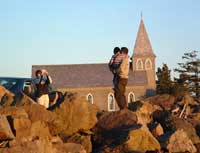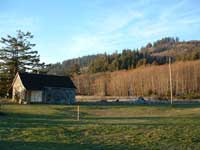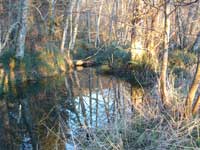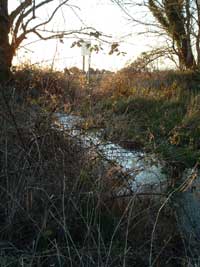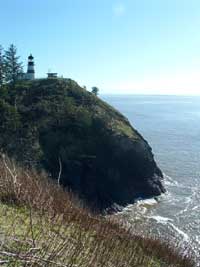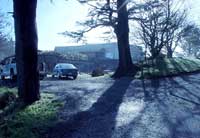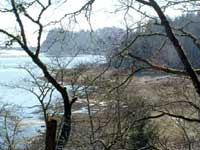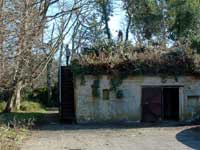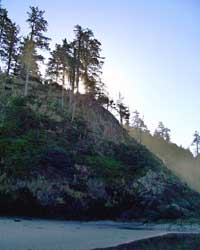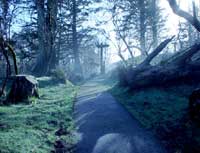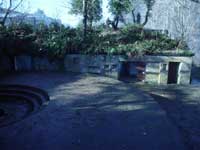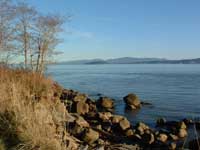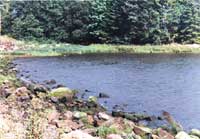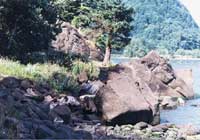|
National Park Service U.S. Department of the Interior Fort Clatsop National Memorial Astoria, Oregon |
 |
Draft Boundary Study and Environmental Assessment
| Environmental Consequences |
Analysis of potential impacts is a critical step in evaluating the comparison of management alternatives and identifying the most effective and efficient alternative. This study analyzes potential impacts related to cultural resources, natural resources, socioeconomic conditions, transportation, and the visitor experience.
Cultural resources at all three sites include archaeological resources of Native American and European American settlements and the cultural landscapes surrounding the sites.
Natural resources common to all sites consist of forested areas; shoreline areas and floodplains; threatened, sensitive, and endangered species; wetlands; streams; and noise and air quality.
Socioeconomic conditions include the economy of local communities, potential job creation, safety and environmental health, potential impacts to agency capital, maintenance and operations costs, and aspects related to private land ownership such as the desire for conservation easements.
Transportation impacts relate to the potential for increased traffic and congestion and the need for enhanced accessibility and safety for all modes of travel.
Lastly, the experience of the visitor is affected by all of these elements, as well as other site specific characteristics such as aesthetics, views and visual characteristics; existing and potential interpretive, educational, recreational opportunities; other existing and potential site functions; and surrounding land uses.
The analysis of each of these five categories of potential impacts associated with the management alternatives is provided on the following pages. In addition to the impacts described in this study, an Environmental Assessment titled U.S. Highway 101 Realignment at Station Camp Park has been prepared detailing more specific project impacts related to highway realignment and park development at the Station Camp site. This document is being prepared for WSDOT on behalf of FHWA and will be available in the near future at the Ilwaco Timberland Library and on the Washington State Department of Transportation website.
Environmental Consequences — Alternative A
No Action: Current Site Management Continues
Cultural Resources
Megler Safety Rest Area
(Clark's Dismal Nitch)
This site currently functions as a WSDOT safety rest area with
surrounding private timber land. Under Alternative A, it would retain
those functions. The consequences of the No Action Alternative on the
cultural resources at the site include a lack of national recognition
for the site's historic value, limited protection for potential existing
archeological resources, and limited protection of the surrounding
cultural landscape.
Under Alternative A, no additional interpretation would be provided leaving visitors with an incomplete story of the dramatic events that took place at the site. While the approximate area where the Expedition was trapped for six days is visible from the safety rest area, it is not accessible to the public since it is on private property. This will remain the situation under this alternative.
|
|
Station Camp
The Station Camp site, under this alternative, would consist of an
improved wayside area owned and maintained by WSPRC. Consequences of
Alternative A on this site include limited protection of potential
archeological resources and limited protection of the surrounding
cultural landscape. Minimal interpretation would likely be provided
resulting in an inability to fully expand the traveling public's
awareness of the Expedition's time at Station Camp, their interactions
with Native American tribes of the area, and other topics.
No Action at this site allows the configuration of the church to remain as it is now. The continued informal and controlled access and parking would remain and the opportunities to improve these conditions that would be realized through Alternatives B, C, and D, would not exist under Alternative A. However, with limited improvements to the site, fewer visitors will be drawn to it, therefore minimizing potential conflicts church attendees may have with Lewis and Clark tourists. However during the bicentennial period, some increased visitation to the site would be expected.
Fort Canby State Park
(Cape Disappointment)
The Lewis and Clark Interpretive Center (LCIC) is undergoing exhibit and
center enhancements prior to the Lewis and Clark Bicentennial. These
enhancements will continue under Alternative A although there would be
limited interpretive connection to the two other Lower Columbia Lewis
and Clark sites. The cultural resources within the park would continue
to be protected under WSPRC management.
Natural Resources
Megler Safety Rest Area
(Clark's Dismal Nitch)
Impacts to natural resources vary for this site under Alternative A. The
scenic backdrop around the safety rest area and the Dismal Nitch
campsite is a steep, rocky, wooded slope with a small creek. A majority
of this area is owned by a timber company with some property ownership
by WSDOT. While the Cathlamet Timber company has left the slope and the
creek in a natural condition in recent years, there is no assurance the
historic forested setting and creek area would remain protected over the
long term. The stability of the slope is also not guaranteed if the
timber is harvested sometime in the future, depending upon the extent of
the harvest and the steepness of the slope.
Station Camp
Much like Clark's Dismal Nitch, Station Camp has a forested backdrop
that looks today much as it did when the Corps of Discovery was there
nearly 200 years ago. The land is owned by family members of the
original European American settlers who have been respectful stewards of
the property for 150 years.
Alternative A, however, does not assure the continued protection of this historic forested landscape. A creek also runs through the Station Camp site but under Alternative A would not be protected or enhanced. As such, fish habitat and passage would not be improved as under the other alternatives. In addition, with no protection of the forested land, slope stability would be an issue if the timber is harvested.
Fort Canby State Park
(Cape Disappointment)
Under the No Action Alternative, there would be no impacts to the
natural resources at Fort Canby State Park.
Socioeconomic Environment
Megler Safety Rest Area
(Clark's Dismal Nitch)
Megler Safety Rest Area is perfectly situated to encourage and orient
tourists traveling from the Seattle or Longview/Kelso areas to other
Lewis and Clark sites in the region. Not improving the site minimizes
the likelihood that tourists will place it on their itinerary for the
purpose of visiting Lewis and Clark sites, thereby shortening the time
they spend in the lower Columbia area and specifically Pacific County,
Washington. The end result would be a lost opportunity for additional
tourism revenues to the local economy, and benefits to the region would
not be as great as under the other alternatives.
|
|
Station Camp
Only three miles away from Megler Safety Rest Area, Station Camp is also
situated to encourage and orient tourists traveling from Seattle and
Oregon to visit other Lewis and Clark sites in Pacific County and
elsewhere in the region. Even with no action to the site, an increase in
visitation during the bicentennial years is expected. Unfortunately the
minimal interpretive information available and the accessibility issues
associated with this site will not significantly increase the amount of
time spent in Pacific County. Similar to Clark's Dismal Nitch, the local
economy will miss out on an opportunity for additional revenue.
The increased visitation does have the potential to increase the impact to the surrounding private property owners. Inadequate parking only ensures that visitors to the site will illegally park on any open grassy area or along the narrow highway shoulder. A current problem that would become substantially worse is the issue of anglers and visitors using the great outdoors as a restroom, creating sanitary and other problems and potentially impacting the private property owners surrounding the site.
Lastly, fishing access to the site would not be improved under this alternative. Fishing does benefit the local economy, but the safety aspects and limited land availability for fishing at this site affects access, safety, and enjoyment of the site.
Fort Canby State Park
(Cape Disappointment)
The ongoing improvements to Fort Canby State Park and the LCIC are
already expected to improve the economy of Pacific County. With more to
see and learn about at the park, more visitors will travel to the state
and lengthen their stay in the region. This translates to more meals
eaten, more souvenirs purchased, and more lodging activity in Pacific
and Clatsop counties.
Transportation
Megler Safety Rest Area
(Clark's Dismal Nitch)
There are no major transportation impacts at this site under Alternative
A as the safety rest area and the highway would maintain current
functions. However, knowledgeable Lewis and Clark enthusiasts may still
visit the site and attempt to cross the highway to access the Dismal
Nitch campsite causing safety concerns.
Station Camp
Several transportation impacts exist at Station Camp and would continue
with no action taken. Parking is inadequate at the site now and during
the bicentennial years, it will only worsen as anglers would continue to
share the limited parking with Lewis and Clark tourists. Alternative A
retains the status quo with regard to anglers' safety. People visiting
the small wayside would continue to experience poor ingress and egress.
With unsafe parking, a high number and variety of users, and inadequate
sight-distance at Station Camp, the transportation issues are
significant.
Not only are anglers and Lewis and Clark visitors negatively impacted by the transportation difficulties, but so are highway drivers. The drivers must deal with illegally parked cars along a curving stretch of highway, pedestrians running spontaneously and unpredictably across the highway, visitors standing along the edge of the highway, and cars pulling in and out of an area where sight-distance is poor. The experience for drivers along this stretch of highway is also compromised under the No Action Alternative.
Fort Canby State Park
(Cape Disappointment)
WSPRC is improving the interpretative center at Fort Canby State Park.
Regional efforts are also underway to improve the transportation to the
LCIC. One potential enhancement includes a proposed shuttle system to
access the park and the center from Ilwaco. Coordination for the system
with both Washington and Oregon transit agencies would be an ongoing
task. Another potential improvement is to build a funicular or elevator
from the parking lot below the LCIC up to the plaza outside the
interpretive center, but this is contingent upon securing funds.
Visitor Experience
Megler Safety Rest Area
(Clark's Dismal Nitch)
Visitors to Clark's Dismal Nitch would experience negative consequences
with the No Action Alternative. The poor potable water service currently
requires seasonal closing of the restrooms. Without potable water in the
winter, the safety rest area cannot maintain its restroom function
year-round. While the remainder of the safety rest area is open all
year, the restrooms are closed during the winter months. Although not an
ideal time to visit the Washington coast, it is the time that the Corps
of Discovery journeyed through the area. Therefore, an increase in
visitation is expected in the winter of 2005, but the No Action
Alternative may limit WSDOT from opening the restrooms to visitors who
are traveling the trail at that time of year.
Other consequences include the lack of additional interpretation at the safety rest area and a lack of visitor access to the historic Dismal Nitch itself. Also, visitors would not have the opportunity to experience other potential enhancements to the site that would likely occur under the other alternatives.
Station Camp
Highway safety issues currently exist at the Station Camp site and with
the anticipated increase in visitation, the situation could worsen. The
lowered ground elevation northeast of the highway prevents people from
standing on that side of the highway to fully view the Columbia River
and the Pacific Ocean.
For this reason, many visitors to the site will risk running across the highway to a narrow shoulder next to the riprap shoreline in order to view the river. Once safely across the highway, visitors will not find a safe observation area. The large riprap boulders along the shoreline are an obstacle and are difficult to navigate while attempting to reach the water. The noise of the traffic is distracting, especially to visitors who had hoped to reflect on the trials, tribulations, and joys of the Corps of Discovery.
For years, anglers have been the prime users of this narrow shoulder, but with the bicentennial, they will be joined by many Lewis and Clark enthusiasts. The existing interpretation on site is inadequate, although interpretives would be improved at the wayside park.
Parking is inadequate now, and anglers use the open area around the church and the highway shoulders to park. The parking situation will only become more problematic as visitors descend on the area. Alternative A does not propose to relieve any of these concerns but only to provide more organized parking, more clearly defined ingress/egress, and better interpretation on the northeast side of the highway as part of an improved state park wayside.
Fort Canby State Park
(Cape Disappointment)
Given the limitations of additional interpretation at Clark's Dismal
Nitch and Station Camp and the significant renovation and interpretive
improvements at the LCIC, visitors would be expected to spend most of
their time at Fort Canby State Park.
The downside to this alternative is minimal interpretive connections to the two other Lewis and Clark sites would be provided and capacity issues with parking and access at Fort Canby may become more of an obstacle. The influx of visitors would not be dispersed effectively and as such, would be more difficult to manage and serve. Another consequence is the state park would not receive a national memorial to recognize the president who commissioned exploration westward.
Cumulative Effects
Alternative A would offer the least enhancement of the visitor experience and commemoration of Lewis and Clark history, and the least protection of cultural and natural resources compared to the other alternatives presented in this study.
Environmental Consequences — Alternative B
Lewis and Clark Washington State Park Sites
Cultural Resources
|
|
Megler Safety Rest Area
(Clark's Dismal Nitch State Park)
With WSPRC owning, managing, protecting the resources, and developing
interpretative facilities at Clark's Dismal Nitch with NPS assistance,
the cultural and historic landscape of this site would receive stronger
protection than under Alternative A. WSDOT would continue to own and
manage the safety rest area through a cooperative agreement with WSPRC.
WSPRC would also acquire through "willing seller" negotiation, a portion
of the private property and obtain a conservation easement over the
surrounding private land. This would protect the archaeological
resources, historic setting, and cultural landscape including the
upstream watershed.
Station Camp State Park
Similar to the situation at Clark's Dismal Nitch, Alternative B would
ensure protection of the approximate campsite location through "willing
seller" negotiation and fee simple acquisition of a portion of the
riverfront property and preservation of the historic forested landscape
surrounding Station Camp through a conservation easement over the
property. Potential archaeological resources at Station Camp would also
receive protection since state and federal laws would apply to any
resources discovered at the site.
As part of the Environmental Assessment for the U.S. Highway 101 realignment through the project area, recommendations were made to measure, draw, and photo-document the standing McGowan buildings in the Station Camp project area. Furthermore, a recommendation was made for a professional archaeologist to be present during the construction of the realignment of U.S. Highway 101 and the proposed Station Camp site development to monitor the most severe ground-disturbing activities. If any significant deposits are found, they should be recovered to prevent damage. Alternative B generates greater protections of cultural resources for Station Camp than Alternative A.
Fort Canby State Park
(Cape Disappointment)
As in Alternative A, the Lewis and Clark Interpretive Center (LCIC) is
undergoing exhibit and center enhancements prior to the Lewis and Clark
Bicentennial. These enhancements will continue under Alternative B. The
difference between Alternative A and B is that under B, there would be a
stronger interpretive connection to the other protected Lewis and Clark
sites being studied since WSPRC would manage these sites as well. No
impacts to cultural resources would be expected within Fort Canby State
Park under this alternative.
Natural Resources
Megler Safety Rest Area
(Clark's Dismal Nitch State Park)
Under Alternative B, protection of many of the natural resources at the
site would be improved compared to Alternative A. WSPRC would acquire,
through "willing seller" negotiation, the Dismal Nitch campsite and
Megler Creek area under Alternative B. This would ensure long-term
protection of the area. In addition, the WSPRC would obtain a
conservation easement over the surrounding wooded backdrop to protect
the area from timber harvesting. Slope stability could also be addressed
by long-term land management policy.
|
|
Station Camp State Park
Ownership and management by the WSPRC of Station Camp would allow for
continued stewardship of the natural resources at the site much as the
private owner has done for the past 150 years. In addition, the WSPRC
would obtain a conservation easement over the surrounding wooded
backdrop to protect the wetlands and habitat from timber harvesting.
An added benefit of WSPRC ownership is the protection of the upstream watershed. Slope stability could be addressed under Alternative B by long-term management policies. Alternative B provides greater protections of natural resources than Alternative A.
A more site specific assessment of effects to endangered species of Station Camp is provided in the Environmental Assessment titled U.S. Highway 101 Realignment at Station Camp Park.
Fort Canby State Park
(Cape Disappointment)
As with Alternative A, there would be no impacts to Fort Canby State
Park's natural resources under Alternative B.
Socioeconomic Environment
In compliance with executive orders 12898 and 13045 the implementation of this alternative would not be expected to have any adverse affects or present any safety or environmental hazards to children. The additional protection of resources and enhanced visitor opportunities would provide an enhanced environment, reduced risks through improved safety and access, and provide overall improved conditions that benefit the health and welfare of all citizens.
Megler Safety Rest Area
(Clark's Dismal Nitch State Park)
The socioeconomic environment would be improved with Clark's Dismal
Nitch becoming a state park. With increased public use, the state park
would become a tourist destination, increasing the time tourists spend
in the area and in Pacific County. As tourists stay longer, Pacific
County as well as regional tourism operations would benefit
economically.
|
|
Station Camp State Park
With Station Camp as an expanded state park, Pacific County and regional
tourism would experience greater benefits than they would with
Alternative A. Station Camp would draw more tourists resulting in more
time spent in Pacific County and the region. More time spent in an area
by tourists would result in more money spent, which would benefit the
regional economy.
As a state park, controlled access to the site, improved parking facilities, and visual screening of park uses would be part of the site development. These improvements would minimize the negative consequences that increased visitation would cause to neighboring property owners.
Fort Canby State Park
(Cape Disappointment)
The improvements underway at Fort Canby State Park are already expected
to improve the economy of Pacific County through increased visitation.
With more to see and learn at the state park, more visitors will travel
to the park and spend more time in the area. Under this alternative,
Fort Canby would be one of three enhanced Lewis and Clark sites for
visitors to see in Pacific County. This translates into a cumulative
tourism benefit because people would stay longer in the area. More meals
would be eaten, more souvenirs purchased, and more overnight stays would
occur in Pacific County. The connection to the three other sites would
likely provide more positive socioeconomic benefits than Alternative A.
Transportation
Megler Safety Rest Area
(Clark's Dismal Nitch State Park)
Despite the change in ownership and management of Clark's Dismal Nitch
to WSPRC, the safety rest area would still be managed by WSDOT and
ingress and egress to the site would be maintained. Safety solutions for
potential pedestrian access across the highway would need to be
addressed early in the process since visitors parking at the safety rest
area would likely try to access the Dismal Nitch campsite and Megler
Creek area. Transportation impacts would be slightly improved from
Alternative A with designated pedestrian safety improvements for
crossing the highway.
Station Camp State Park
Under Alternative B, the transportation issues at Station Camp would be
improved greatly over Alternative A. Site access would be safer and
parking facilities would be improved, including a capacity increase.
Safety concerns would be eliminated as anglers and motorists are
separated, and the horizontal alignment of the highway would be
improved. Pedestrian access to Fort Columbia State Park from Station
Camp is being explored through a potential trail link. This link has the
potential to immerse the hiker into the historic forested backdrop,
reminiscent of what Lewis and Clark experienced almost 200 years ago.
|
|
Fort Canby State Park
(Cape Disappointment)
WSPRC is improving the building and interpretive exhibits at the LCIC,
and regional efforts are also underway to improve transportation to the
park and the LCIC. One potential enhancement includes a proposed shuttle
system to access the park from Ilwaco. Under Alternative B, the shuttle
system could expand to include links to Clark's Dismal Nitch and Station
Camp.
Coordination for the system with both Washington and Oregon transit agencies would be an ongoing task. Another potential improvement is for an elevator or funicular from the lower level parking lot to provide access to a new plaza area outside the LCIC, although this project is contingent upon securing funds for design and construction.
Visitor Experience
Megler Safety Rest Area
(Clark's Dismal Nitch State Park)
The visitor experience at Clark's Dismal Nitch would be enhanced under
Alternative B since the site would become a state park. As a state park,
recognition and interpretation of the Corps of Discovery's time at the
site would be enhanced through outdoor interpretive panels and trail
access to the Dismal Nitch.
Opportunities would be explored to provide public access to the area of the Dismal Nitch campsite through separate parking on the north side of the highway or a safe pedestrian highway crossing.
Unlike the current situation, the facility may be open year-round if a solution for the potable water supply is identified through a cooperative agreement with WSDOT. The potable water issues would need to be addressed by WSDOT and WSPRC to allow for full season use of the restrooms.
Station Camp State Park
Visitor experience at Station Camp would be greatly improved over
Alternative A if the site were an expanded state park as in this
alternative. Site development would occur at Station Camp enhancing the
visitor experience through recognition and interpretation of Lewis and
Clark historic events that occurred at the site. Improvements to the
visitor experience would include riverfront access, outdoor interpretive
panels, comfort station, upgraded parking capacity, better
ingress/egress, and river and ocean viewpoints. The site development
would also improve safety for anglers using the site.
A potentially negative consequence for passing motorists would be a greater separation from the water's edge affecting views out to the river. However, the positive consequences for passing motorists would be an improved highway alignment, fewer potential pedestrian conflicts in this area, and the ability to stop at the park to rest, use the restroom facilities, and get out of the car to experience the view.
|
|
Fort Canby State Park
(Cape Disappointment)
As in Alternative A, the LCIC interpretive improvements and center
renovation would continue under Alternative B. Unlike Alternative A,
interpretive connections to the other protected Lewis and Clark sites
would be enhanced since all three sites would be managed by the WSPRC.
This alternative would not include recognition of our third president
through a Thomas Jefferson National Memorial.
Cumulative Effects
Overall, implementation of this alternative would result in enhanced preservation of both natural and cultural resources and increased opportunities for the public to enjoy and appreciate Lewis and Clark history. In addition, implementation of this alternative would not cause an impairment to park resources.
Environmental Consequences — Alternative C
Expansion of National Memorial and Washington State Park Sites
Cultural Resources
Megler Safety Rest Area
(Clark's Dismal Nitch State Park)
With WSPRC owning, managing, protecting the resources, and developing
interpretative facilities at Clark's Dismal Nitch with NPS assistance,
the cultural landscape of this site would receive much stronger
protections than under Alternative A, but similar to Alternative B.
WSDOT would continue to own and manage the safety rest area through a
cooperative agreement with WSPRC. WSPRC would acquire the private
property at the Dismal Nitch site and obtain a conservation easement
over the surrounding private land. This would protect the historic
setting and cultural landscape including the upstream watershed.
Station Camp
(Unit of Fort Clatsop National Memorial)
Similar to the situation at Clark's Dismal Nitch, Alternative C would
ensure protection of the Station Camp site through "willing seller"
negotiations and fee simple acquisition while preserving the historic
forested landscape surrounding Station Camp through a conservation
easement. The NPS would own and manage the site as a unit of Fort
Clatsop National Memorial. Potential archaeological resources at Station
Camp would receive additional protection since the site would fall under
federal management. Laws that would apply include the National Historic
Preservation Act and the National American Graves Protection and
Repatriation Act.
As part of the Environmental Assessment for the U.S. Highway 101 realignment through the area, recommendations were made to measure, draw, and photo document the standing McGowan buildings in the Station Camp project area. Furthermore, a recommendation was made for a professional archaeologist to be present during the construction of the realignment of U.S. Highway 101 and the proposed Station Camp site development to monitor the most severe ground-disturbing activities. If any significant deposits are found, they should be recovered to prevent damage.
As a result, Alternative C would provide stronger protections of cultural resources than both Alternative A and B.
|
|
Fort Canby State Park and Thomas Jefferson National Memorial
Proposed improvements to the LCIC will continue under all alternatives,
including Alternative C. As in Alternative B, this alternative also
would enhance the interpretive connection between Fort Canby State Park,
Clark's Dismal Nitch, and Station Camp. This alternative would also
include development of a Thomas Jefferson National Memorial (TJNM). The
memorial development area would have a small imprint on the land
covering less than an acre and would be surrounded by a maximum of 10
acres as part of the memorial boundary.
The site design of the memorial would commence after an assessment of the existing resources. Development would then need to be cognizant of the existing cultural resources, which include the dormitory foundation, water tower, and other architectural remains. The TJNM will provide a fitting memorial to Thomas Jefferson's vision of creating a Nation from "sea to shining sea." The impacts to cultural resources will be similar to Alternatives A and B.
Natural Resources
Megler Safety Rest Area
(Clark's Dismal Nitch State Park)
Under Alternative C, protection of many of the natural resources at the
site would be improved over Alternative A and comparable to Alternative
B. WSPRC would acquire the Dismal Nitch site and Megler Creek area as
under Alternative B. This would ensure long-term protection of the
natural resources immediately adjacent to the historic site. In
addition, the WSPRC would obtain a conservation easement over the
surrounding wooded backdrop to protect the area from timber harvesting.
Slope stability also could be addressed by a long-term land management
policy.
Station Camp
(Unit of Fort Clatsop National Memorial)
Ownership and management by the NPS of Station Camp would allow
additional protection of the historic cultural landscape. A conservation
easement over the surrounding forested backdrop would be obtained from
the private owner through "willing seller" negotiation to preserve this
historic landscape.
Protection of the upstream watershed and Class I and II wetlands through the conservation easement would provide long-term protection to water quality and slope stability. In addition, under NPS management, Station Camp would fall under the protection afforded to federally owned lands through NEPA and Section 7 of the Endangered Species Act.
|
|
Fort Canby State Park and Thomas Jefferson National Memorial
Development of the Thomas Jefferson National Memorial within Fort Canby
would be designed to be sensitive to the protection of natural resources
such as rare plant species, the existing coastal spruce forest,
threatened and endangered species, migratory bird habitat, and the
issues of slope stability and erosion. A more detailed assessment of
these natural resources would be completed prior to final design through
separate environmental analysis.
The majority of the 10-acre memorial would be left protected in its natural setting with the provision of pedestrian only access to the site. The memorial site would be in a prominent location in relation to the LCIC, but would have minimal impacts to the current plan for the LCIC. Whenever possible, existing infrastructure supporting the LCIC would be utilized in cooperation with the WSPRC. No natural resource impacts are expected with this alternative.
Socioeconomic Environment
In compliance with executive orders 12898 and 13045 the implementation of this alternative would not be expected to have any adverse affects or present any safety or environmental hazards to children. The additional protection of resources and enhanced visitor opportunities would provide an enhanced environment, reduced risks through improved safety and access, and provide overall improved conditions that benefit the health and welfare of all citizens.
Megler Safety Rest Area
(Clark's Dismal Nitch State Park)
The socioeconomic environment of the region would be improved with
Clark's Dismal Nitch becoming a state park. With increased public use,
the state park would become a tourist destination, increasing the time
that tourists spend in the area and in Pacific County. As tourists stay
longer, Pacific County, as well as regional tourism operations, would
benefit economically. The socioeconomic benefits of Alternative C are
greater than Alternative A and comparable to Alternative B.
Station Camp
(Unit of Fort Clatsop National Memorial)
With Station Camp under NPS management, Pacific County and regional
tourism would experience greater benefits from increased visitation than
in Alternatives A and B. The national designation of the site as a unit
of Fort Clatsop National Memorial would draw more tourists to the site
resulting in more time spent in Pacific County and the region.
Fort Canby State Park and Thomas Jefferson National Memorial
Improvements planned for the LCIC and Fort Canby State Park are already
expected to benefit the economy of Pacific County through increased
visitation. Additional visitation would be expected at Fort Canby State
Park and the area under Alternative C due to the national recognition
and establishment of the Thomas Jefferson National Memorial. With more
to see and learn, more visitors will travel to the site and spend longer
periods of time in the region. Under this alternative, Fort Canby
becomes one of three enhanced Lewis and Clark sites in Pacific County.
The economic benefits of Alternative C are greater than Alternatives A
or B with the addition of the TJNM.
Transportation
Megler Safety Rest Area
(Clark's Dismal Nitch State Park)
Despite the change in ownership and management of Clark's Dismal Nitch
to WSPRC, the safety rest area would still be managed by WSDOT and
ingress and egress to the site would be maintained. Pedestrian access
across the highway would need to be addressed, since visitors parking at
the safety rest area may try to traverse the highway to access the
Dismal Nitch campsite. Transportation impacts for Alternative C are
minimal and comparable to Alternative B.
Station Camp
(Unit of Fort Clatsop National Memorial)
Under Alternative C, the transportation issues at Station Camp would be
improved greatly over Alternative A and similar to Alternative B. Site
access would be safer and parking facilities would be improved including
a capacity increase. During peak visitation periods, shuttle service to
Station Camp would likely be required to augment on-site parking. Safety
would be enhanced as anglers and motorists are separated and the
horizontal alignment of the highway is improved. Pedestrian access to
Fort Columbia State Park from Station Camp would be explored through a
trail link. This link has the potential to immerse the hiker into the
historic forested backdrop reminiscent of what Lewis and Clark
experienced.
|
|
Fort Canby State Park and Thomas Jefferson National Memorial
As part of the LCIC renovations, transportation improvements to the
park and the LCIC are also being planned. As a state park that includes
the Thomas Jefferson National Memorial, the park would experience an
increase in visitation. The existing parking lot at the LCIC would be
inadequate to accommodate the increase in visitors during the peak
season. The increase in visitation would provide more transportation
impacts to the state park than in Alternatives A or B. As a result,
increased shuttle service would be proposed beyond the improvement that
WSPRC was already proposing as part of the LCIC enhancements.
As in Alternative B, the shuttle system may include links to Clark's Dismal Nitch and Station Camp. Coordination for the system would be conducted with both Washington and Oregon transit agencies. Another potential improvement is an elevator or funicular from the lower level parking lot to the plaza outside the LCIC, but this is contingent upon WSPRC securing funds for design and construction.
Visitor Experience
Megler Safety Rest Area
(Clark's Dismal Nitch State Park)
The visitor experience at Clark's Dismal Nitch would be enhanced by
visitor improvements and a collaborative management agreement between
WSPRC and WSDOT. These improvements would provide a better visitor
experience than Alternative A and a similar experience to Alternative
B.
With WSPRC management at the site, interpretation of the Corps of Discovery's time at the site would be greatly enhanced through additional outdoor interpretive panels and trail access to the Dismal Nitch campsite. Unlike the current situation, the restrooms would potentially be open year-round through an agreement with WSDOT. The potable water issues would need to be addressed by WSDOT and WSPRC to allow for full-season use of the restrooms.
Station Camp
(Unit of Fort Clatsop National Memorial)
Site development would occur at Station Camp enhancing the visitor
experience through recognition and interpretation of Lewis and Clark
events at the site. The visitor experience under Alternative C is
greatly improved over Alternative A and similar to Alternative B,
although the connection of interpretive themes to Fort Clatsop National
Memorial would be greatly strengthened through the influence of NPS
management. Also, there would be opportunities to strengthen
interpretive connections with Fort Canby State Park and Clark's Dismal
Nitch through collaborative management with the WSPRC.
Improvements to the visitor experience would include riverfront access, outdoor interpretive panels, a comfort station, upgraded parking capacity, safe ingress/egress, and waterfront viewpoints. The site development would provide better access for bank fishing. The site design would emphasize the national significance of the site and NPS presence.
A potential negative consequence for passing motorists would be a greater separation from the water's edge affecting views out to the river. However, the positive consequences for passing motorists would include improved highway alignment, fewer potential pedestrian conflicts in this area, and the opportunity to stop at the park to rest, get out of the car to experience the views, and use the facilities.
Fort Canby State Park and Thomas Jefferson National Memorial
The LCIC interpretive improvements and center renovation would continue
under Alternative C with interpretive connections to Clark's Dismal
Nitch and Station Camp. Since this alternative includes a Thomas
Jefferson National Memorial, interpretation of Jefferson's role in the
Expedition and in nation building would greatly improve the visitor
experience over Alternatives A and B. Visitors would be able to
understand and appreciate the importance of Jefferson's vision with the
creation of the memorial.
There are potential impacts to the viewshed of the bluff from the beach and jetty area as a result of the creation of a Jefferson Memorial, but these would likely be minimal. Capacity issues with parking and access at the LCIC and the site of the national memorial would be more of an obstacle with increased visitation, and would need to be resolved through future design and coordination between the NPS and WSPRC.
Cumulative Effects
Overall, implementation of this alternative would result in enhanced preservation of both natural and cultural resources and increased opportunities for the public to enjoy and appreciate Lewis and Clark history.
Implementation of this alternative and the potential addition of these lower Columbia Lewis and Clark sites to Fort Clatsop National Memorial would not cause an impairment to park resources. Instead, the potential addition of these sites would help to complement and round out the interpretive story and mission of the park.
Environmental Consequences — Alternative D
Lewis and Clark National and State Historical Park
Cultural Resources
Clark's Dismal Nitch
(Unit of Lewis and Clark National Historical Park)
Alternative D would ensure protection of the historic forested setting, creek
area, and safety rest area property at Clark's Dismal Nitch through NPS
management. The nitch area would be protected through fee simple ownership
and management by the NPS, and the surrounding historic cultural
landscape would be protected by a conservation easement over the privately
owned property. In addition, WSDOT would transfer ownership of all property
outside the highway right-of-way to the NPS.
Potential archaeological resources at the Dismal Nitch would receive additional protection since the site would fall under federal laws. Applicable laws include the National Historic Preservation Act and the National American Graves Protection and Repatriation Act. This alternative would provide the highest degree of protection for the cultural resources compared to Alternatives A, B, and C.
Station Camp
(Unit of Lewis and Clark National Historical Park)
Similar to the situation at Clark's Dismal Nitch, Alternative D would
ensure protection of the historic forested landscape, historic church,
and the Station Camp site area through NPS management of the site. The
Station Camp site would be protected through fee simple ownership and
management by the NPS, and the surrounding historic cultural landscape
would be protected by a conservation easement over the privately owned
property.
As part of the Evironmental Assessment for the U.S. Highway 101 realignment through the area, recommendations were made to measure, draw, and photo document the standing McGowan buildings in the Station Camp project area. Furthermore, a recommendation was made for a professional archaeologist to be present during the construction of the realignment of U.S. Highway 101 and the proposed Station Camp site development to monitor the most severe ground-disturbing activities. If any significant deposits are found, they should be recovered before being destroyed.
Potential archaeological resources at Station Camp would receive additional protection since the site would fall under federal management. Laws that would apply include the National Historic Preservation Act and the National American Graves Protection and Repatriation Act. This alternative would provide a higher degree of protection for the cultural resources compared to Alternatives A and B and similar protections compared to Alternative C.
|
|
Fort Canby State Park and Thomas Jefferson National Memorial
Improvements to the LCIC and Fort Canby State Park will be completed
under all alternatives, including Alternative D. As in Alternative B and
C, this alternative also would retain the interpretive connection to
Clark's Dismal Nitch and Station Camp and is strengthened by NPS
involvement at all three sites. As with Alternative C, this alternative
would include development of a Thomas Jefferson National Memorial
(TJNM).
The memorial would have a small imprint on the land covering less than an acre and would be surrounded by a maximum of 10 acres, as part of the memorial boundary. The site design of the memorial would be commenced after an assessment of the existing resources. Development would then need to be cognizant of the existing cultural resources which include the dormitory foundation, water tower, and other architectural remains. The TJNM would provide a fitting memorial to Thomas Jefferson's vision to create a Nation from "sea to shining sea." Alternative D provides the highest degree of protection for cultural resources in comparison to Alternatives A, B, and C.
Natural Resources
Clark's Dismal Nitch
(Unit of Lewis and Clark National Historical Park)
Under Alternative D, protection of the natural resources at the site
would be greater than Alternatives A, B, and C since the property would
be owned by the NPS. In addition, the potential exists for reduction in
the paved surfaces through redesign of the safety rest area site and
resolution of the potable water issue by eliminating the rest area and
restroom function. Night sky viewing opportunities would be enhanced
contingent on lighting changes at the site.
Ownership by the NPS of the Dismal Nitch area would afford additional protection to the natural resources on site under the National Environmental Policy Act (NEPA) and Section 7 of the Endangered Species Act. The potential erosion of the steep slope areas would be mitigated by implementation of long term protection of the forested land around the site through a conservation agreement with the private property owners. This alternative would provide the highest degree of protection for the natural resources compared to Alternatives A, B, and C.
Station Camp
(Unit of Lewis and Clark National Historical Park)
Ownership and management of Station Camp by the NPS allows additional
protection of the natural resources. Protection of the upstream
watershed through a conservation easement over the privately owned land
would provide long-term improvements to water quality and slope
stability and ensure protection of the timber from harvesting.
Station Camp would fall under the protection afforded to federally owned lands through NEPA and Section 7 of the Endangered Species Act. This lternative would provide a higher degree of protection for the natural resources compared to Alternatives A and B and similar protections compared to Alternative C.
|
|
Fort Canby State Park and Thomas Jefferson National Memorial
Development of the Thomas Jefferson National Memorial within Fort Canby
State Park would be sensitive to the protection of natural resources
such as rare plant species, the existing coastal spruce forest, Class I
and II wetlands, threatened and endangered species, migratory bird
habitats, and the issues of slope stability and erosion. Assessment of
these natural resources would be completed prior to final design. The
majority of the 10-acre memorial would be left protected in its natural
setting with only pedestrian access provided to the site. The memorial
site would be in a prominent location in relation to the LCIC, but yet
have minimal impacts to the current plans for the LCIC.
Whenever possible, existing infrastructure supporting the LCIC would be utilized in cooperation with the WSPRC. This alternative would provide a higher degree of protection for the natural resources compared to Alternatives A and B and similar protections compared to Alternative C.
Socioeconomic Environment
In compliance with executive orders 12898 and 13045 the implementation of this alternative would not be expected to have any adverse affects or present any safety or environmental hazards to children. The additional protection of resources and enhanced visitor opportunities would provide an enhanced environment, reduced risks through improved safety and access, and overall improved conditions that benefit the health and welfare of all citizens.
Under this alternative the regional economy would be expected to realize greater benefits since the entire lower Columbia region would be marketed under the Lewis and Clark banner and name recognition.
|
|
Clark's Dismal Nitch
(Unit of Lewis and Clark National Historical Park)
Under Alternative D, Clark's Dismal Nitch would be managed as a unit of
the Lewis and Clark National Historical Park. The historical park would
be conducive to regional marketing of the lower Columbia Lewis and Clark
experience, providing an economic benefit to Washington and Oregon
tourism, especially for Pacific and Clatsop counties.
The socioeconomic environment would be improved with Clark's Dismal Nitch being managed by the NPS. The addition of the NPS arrowhead would create national recognition for the site, drawing in additional tourists, who in turn would increase their time spent in the area. As tourists stay longer, Pacific County, as well as regional tourism operations, would benefit economically. This alternative would provide the most positive socioeconomic impacts to the region of the alternatives considered.
Station Camp
(Unit of Lewis and Clark National Historical Park)
Under Alternative D, Station Camp would be managed as a national park
unit of the Lewis and Clark National Historical Park. The historical
park would be conducive to regional marketing of the lower Columbia
Lewis and Clark experience, providing additional emphasis to the
economic benefit to Washington and Oregon tourism especially for Pacific
and Clatsop counties.
With Station Camp under NPS management, Pacific County, and regional tourism operations, would experience significant symbolic and economic benefits. The national designation of the site as a unit of the Lewis and Clark National Historical Park would draw more tourists to the site, resulting in more time spent in Pacific County and in the region. This alternative would provide the most positive socioeconomic impacts to the region of the alternatives considered.
Fort Canby State Park and Thomas Jefferson National Memorial
Under Alternative D, Fort Canby State Park would be managed by the WSPRC
and the Thomas Jefferson National Memorial would be managed as a unit of
the Lewis and Clark National Historical Park. The historical park would
be conducive to regional marketing of the lower Columbia Lewis and Clark
experience. This would provide an economic benefit to Washington and
Oregon tourism especially for Pacific and Clatstop counties. The economy
of Pacific County is already expected to improve through increased
visitation at Fort Canby State Park and LCIC as a result of the planned
interpretive improvements at the site.
Additional visitation also would be expected at Fort Canby State Park and the area due to the national recognition and establishment of the Thomas Jefferson National Memorial under this alternative. With more to see and learn, more visitors would travel to the site and increase their time spent in the area, resulting in additional economic benefits for the local communities. This alternative would provide the most positive socioeconomic impacts to the region of the alternatives considered.
In addition to the three Washington sites, Ecola and Fort Stevens state parks would continue to be managed by the OPRD within the broader context of the Lewis and Clark National and State Historical Park. This would provide visitors with enhanced interpretive programming and managers with additional opportunities to promote all of the Lewis and Clark sites in the region.
Transportation
|
|
Clark's Dismal Nitch
(Unit of Lewis and Clark National Historical Park)
The designation of a National and State Historical Park would be
expected to encourage a more coordinated transportation system for the
general public in preparation for the bicentennial and beyond. With the
relocation of the WSDOT safety rest area, the parking and visitor use
demands would decrease, allowing a reduction in parking capacity. With
the parking reduced and a new site design, a regional shuttle system
would provide better access to the site during peak periods. This would
result in more reliance on the transit shuttle services at Clark's
Dismal Nitch during events and peak use.
No additional impacts to highway use would be expected except for improved pedestrian access across the highway to the Dismal Nitch site. With the relocation or removal of the safety rest area, Alternative D would have the least transportation impacts of the alternatives considered.
Station Camp
(Unit of Lewis and Clark National Historical Park)
In addition, the overarching coordination associated with the historical
park may offer opportunities for enhanced public transportation system
operations.
During peak visitation periods, shuttle service to Station Camp would likely be required to augment on-site parking. Safety concerns would be eliminated as anglers and motorists are separated and the horizontal alignment of the highway would be improved. Access to Fort Columbia State Park from Station Camp would be explored through a potential trail link. This link has the potential to immerse the hiker into the historic forested backdrop reminiscent of the landscape Lewis and Clark experienced.
Fort Canby State Park and Thomas Jefferson National Memorial
The designation of a National and State Historical Park would be
expected to encourage a more coordinated transportation system for the
general public in preparation for the bicentennial and beyond. As part
of the LCIC renovations, transportation improvements to the park and
LCIC are also being planned.
With the establishment of the Thomas Jefferson National Memorial, the park would experience an increase in visitation. The existing parking lot at the LCIC would be inadequate to accommodate the increase in visitors during the peak season. As a result, increased shuttle service would be required above the amount WSRRC was proposing as part of the LCIC enhancements.
As in Alternatives B and C, the shuttle system would likely include links to Clark's Dismal Nitch and Station Camp. Coordination for the system would be conducted with both Washington and Oregon transit agencies. In addition, the overarching coordination associated with the historical park would provide better transportation shuttle solutions than likely would occur under the other alternatives.
The scheduled service improvements by area transportation providers would benefit from the coordinated public information approach provided by this alternative.
Visitor Experience
Designation of the Lewis and Clark National and State Historical Park would provide the opportunity for greater coordinated public understanding of the Lewis and Clark experience in the lower Columbia region. For the NPS and Washington and Oregon State Parks, it would provide a better forum for coordinating interpretation and individual site management while respecting the jurisdictional responsibilities of each entity.
|
|
Clark's Dismal Nitch
(Unit of Lewis and Clark National Historical Park)
Overarching collaborative management of all Washington and Oregon Lewis
and Clark sites by the NPS in cooperation with Washington and Oregon
State Parks would provide the public with better interpretive
coordination and unifying historical themes. Clark's Dismal Nitch would
have continuity with other NPS units through management by the Lewis and
Clark National Historical Park. Coordinated interpretation with Station
Camp and other Lewis and Clark sites would also occur under Alternative
D. This alternative would provide the highest level of visitor
experience compared to the other alternatives being considered.
Station Camp
(Unit of Lewis and Clark National Historical Park)
Overarching collaborative management of all Washington and Oregon Lewis
and Clark sites by the NPS in cooperation with Washington and Oregon
State Parks would provide the public with better interpretive
coordination and unifying historical themes. Site development at Station
Camp would enhance the visitor experience through recognition and
interpretation of Lewis and Clark events at the site. Interpretive ties
would also be strengthened to other units of the Lewis and Clark
National Historical Park with the influence of NPS management. The site
development would provide safe and improved access to bank fishing. The
site design would emphasize the national significance of the site since
the site would be managed by the NPS.
A potential negative consequence for passing motorists would be a greater separation from the water's edge affecting views out to the river. However, the positive consequences for passing motorists would include an improved highway alignment, fewer potential pedestrian conflicts in this area, and the ability to stop at the park to rest, get out of the car to experience the views, and use the facilities. This alternative would provide the highest level of visitor experience compared to the other alternatives.
Fort Canby State Park and Thomas Jefferson National Memorial
Overarching collaborative management of all Washington and Oregon Lewis
and Clark sites by the NPS in cooperation with Washington and Oregon
State Parks would provide the public with better interpretive
coordination and unifying historical themes.
The LCIC interpretive improvements and center renovation would continue under Alternative D with interpretive connections to Clark's Dismal Nitch and Station Camp. Since this alternative includes a Thomas Jefferson National Memorial, interpretation of Jefferson's role in the expedition and in nation building would greatly improve the visitor experience over Alternatives A and B and would be similar to Alternative C. With the creation of the memorial, visitors would be able to understand and appreciate the importance of Jefferson's vision. There may be potential impacts to the viewshed of the bluff from the beach and jetty area as a result of the creation of a Jefferson memorial, but these would be minimal.
Capacity issues with parking and access to the LCIC and the site of the national memorial could potentially be more of an obstacle with increased visitation, and would need to be resolved through design and coordination between NPS and WSPRC, as well as through potential transit/shuttle service options. This alternative would provide the highest level of visitor experience in comparison with other alternatives.
Cumulative Effects
Overall, implementation of this alternative would result in enhanced preservation of both natural and cultural resources and increased opportunities for the public to enjoy and appreciate Lewis and Clark history.
The coordinated approach among state and federal agencies managing Lewis and Clark resources would expand opportunities for the public to have an informed and valued experience.
Implementation of this alternative and the potential addition of these lower Columbia Lewis and Clark sites to Fort Clatsop National Memorial would not cause an impairment to park resources. Instead, the potential addition of these sites and the added collaboration with Washington and Oregon State Parks would help to complement and round out the interpretive story and mission of the park.
Environmentally Preferred Alternative
Lewis and Clark National and State Historical Park
Environmentally Preferred Alternative
The National Park Service would consider Alternative D as the environmentally preferred alternative over the No Action Alternative and Alternatives B and C.
The environmentally preferred alternative is defined as the alternative that causes the least damage to the biological and physical environment. It is also the alternative which best protects, preserves, and enhances historic, cultural and natural resources.
Under Alternative D, all three sites that were the subject of the study would receive the consistent protection of their cultural, natural, and scenic resources under the management of the National Park Service in accord with federal laws and departmental and bureau policies. This would provide for a continuity of efficient site management and resource protection. Additionally, the coordinated approach advanced in Alternative D concerning the framework for coordination among Washington and Oregon State Parks and the National Park Service would provide the greatest opportunity for the additional protection of resources while allowing for additional opportunities for public education, use and enjoyment at each of these three sites.

View of sunset across the Columbia River
| <<< Previous | > Contents < | Next >>> |
focl/draft_boundary_study/sec7.htm
18-Jul-2003
